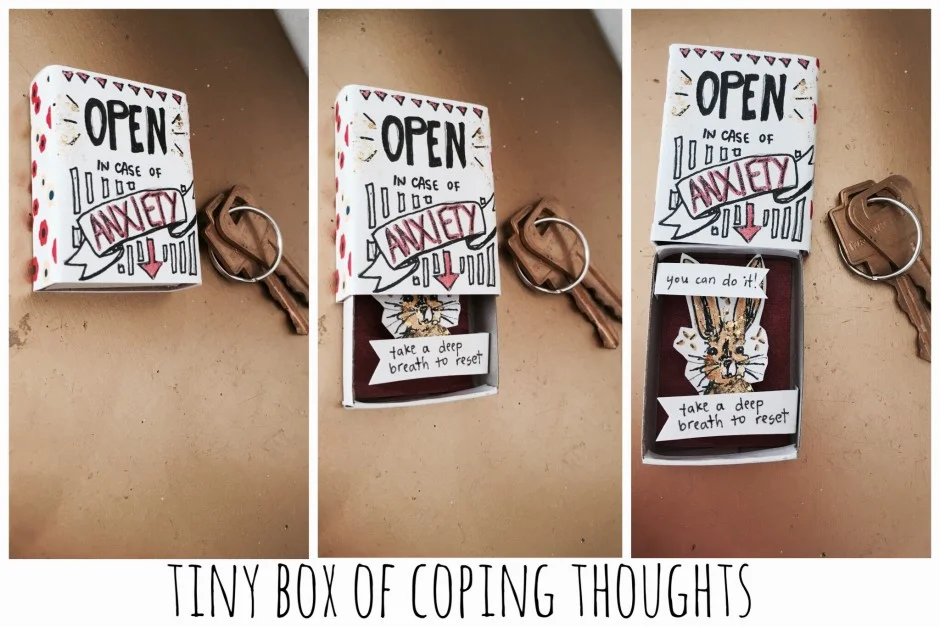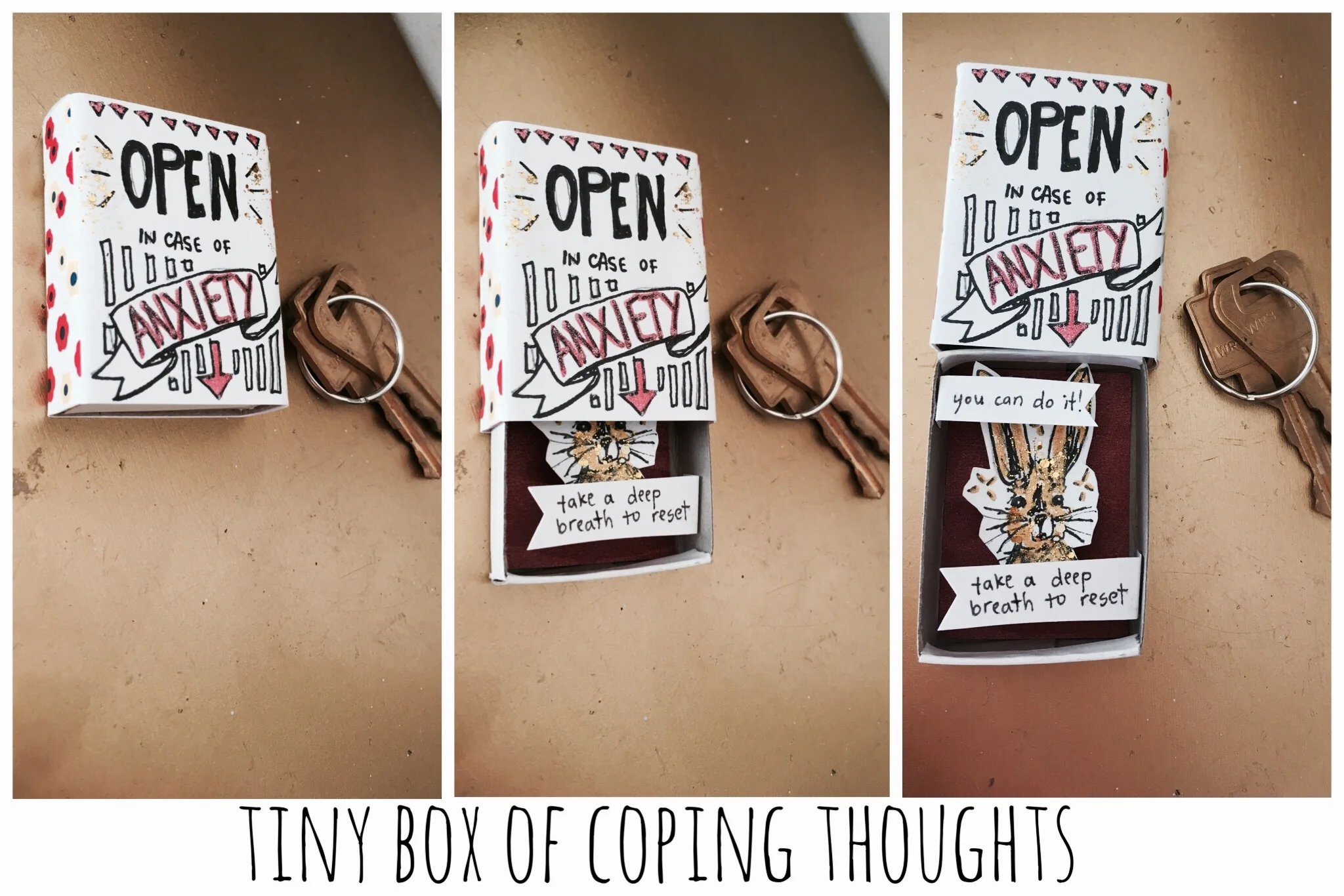For many, September brings a sense of new beginnings and a chance for a fresh start. High school students may see the dawning of a new school year as an opportunity to reinvent themselves socially – to make new friends, to try a new style, or to join a club. While offering many valuable learning opportunities, the social dynamics of high school can bring tremendous pressure and may trigger some anxiety. In our work at Art as Therapy we often find that friendships and social dynamics are a big cause of anxiety as teens head back to school. Teens may worry about how their peers will react to a new hairstyle, or have fears around not knowing anyone in class, or feel anxious that they will not fit in with the desired group.
It’s perfectly normal to experience some anxiety before big life transitions such as starting high school for the first time or moving to a new school. Anxiety’s job is to help us to prepare for danger, so anxiety is activated in unfamiliar situations because we don’t know what to expect. It can help us to get ready for new experiences. For instance, anxiety about being late on the first day of school can motivate us to practice the bus route and time how long the journey will take. Check out our previous blog post for some creative strategies for managing back to school anxiety (Creative Strategies).
Anxiety can become excessive or problematic when it’s constantly being activated in situations that are not new, or present no real danger or threat. For some teens, this takes the form of social anxiety where they become overly afraid of being embarrassed in front of or judged by others. From a developmental perspective, teens are at a stage where peer relationships are very important to them. They look to their friends for emotional support, acceptance, and validation. This means that when friendships don’t come as easily or when teens feel excluded, it can have a big impact on their emotions and self esteem.
There are a number of warning signs that a teen may be experiencing some social anxiety. They may start withdrawing from social activities such as extracurricular clubs or sports. They may find excuses like stomach aches or headaches to avoid social situations such as field trips or parties. Depending on the severity of the anxiety, some high school students may even refuse going to school. More subtle sings may include that the teen is uncomfortable talking to new adults, or to teachers and peers. He or she may blush, avoid eye contact, and shake or tremble in a situation where conversation is expected. He or she may also express excessive worry about saying something stupid or doing something embarrassing. Each time the teen avoids a social situation, it reinforces the belief that the situation is frightening or threatening. Avoidance can increase anxiety, and isolation from friends and peers can lead to feelings of low self esteem and depression.
If teens are struggling with social anxiety, chances are that they are feeling disempowered and are not able to access or utilize effective coping strategies. At Art as Therapy we support children and teens that may be experiencing social anxiety. Individual or group art therapy can help teens to discover positive coping strategies that fit their unique needs. The process of co-creating coping strategies is empowering, and the act of making something often contributes to positive self esteem. Equipped with tools for managing anxiety, teens can spend less time worrying about worst case scenarios and more time engaging with and building those all-important peer relationships.
Today we’re sharing three general tips to help teens manage social anxiety.
- Learn to relax when anxiety is in full swing. The first step in managing any kind of anxiety is knowing what to do when that anxiety is triggered and takes over. When we feel anxious and overwhelmed, our bodies physiologically go into fight or flight mode. When this happens, stress hormones are activated and we can only access the lower functions of the brain, meaning that we can’t think rational thoughts or figure out a logical solution. The best way to reset our bodies and minds is through deep breathing. Oxygen calms the nervous system and allows our bodies to relax. After we have relaxed, we can then replace anxious or unrealistic thoughts with more realistic ones, and figure out how to cope with the situation. Follow the link for an infographic explaining our favourite deep breathing technique called “Take 5 Breathing” (Take Five).
- Use positive coping thoughts to challenge anxious thoughts. When we experience anxiety, we often think repetitive negative thoughts or imagine the worst case scenario. For example, if a teen is anxious about walking into the cafeteria for lunch, he or she may think “No one likes me. Everyone will stare at me and laugh. I’ll never make any friends.” These negative thoughts increase the anxiety and perpetuate the feeling that eating lunch in the cafeteria is scary and should be avoided. We can cope with anxiety by replacing negative thoughts with more realistic coping thoughts. In this case, a coping thought may be “Everyone feels nervous on their first day of high school. I know a few students from last year so maybe I could sit with them. I’ve made friends before so I can make friends again.” We can also use positive self talk as encouragement when facing an anxiety-provoking situation. Some examples of positive self talk include “I can do hard things. I will try my best. I believe in myself.” It takes practice to replace negative thoughts with positive ones and it can be challenging to remember these positive coping thoughts in the moment. That’s why it can be helpful to create physical, visual reminders of positive coping thoughts that you can look at and read in overwhelming situations.
Try making a tiny box of coping thoughts. Take an empty match box and cover it with decorative paper. Use art materials to place your positive coping thought(s) inside the box. You can be as creative as you like – try making pop out characters or banners. Use colours and images that make you feel happy, calm, or loved. You can write instructions on the outside of the box, or decorate it any way you like. Check out the example in the photo with this post. This tiny box is now a tool that you can use to manage social anxiety. When you’re feeling anxious, open your tiny box and read the positive statement to yourself. Try repeating it in your head every time the negative thought comes back. Use these positive thoughts to empower yourself to stand up to anxious thoughts. Keep your tiny box in your locker or pencil case so you can look at it any time you need some encouragement.
Start with the least scary situation and practice! While everything about social anxiety makes teens want to avoid social interactions, avoidance can make the anxiety worse. After you feel equipped with some positive coping strategies, the best way to manage anxiety is to work up to facing those fears. Try making a list of all of the situations or scenarios that trigger anxiety. Then rank them from the least to the most frightening. Focus on the situation that is the least frightening. Figure out how you can use your positive coping strategies to support you through that situation. Make a goal to try facing that situation, and plan a reward for doing so. This doesn’t have to be big or expensive – the award could be as simple as planning to take a bath with some essential oils after school, or watching a new episode of a favourite tv show. The important thing is to set a small goal, face the situation, and then reward yourself for facing your fear and attempting to use positive coping strategies. Know that you will experience some anxiety when you face these situations – that’s what the coping strategies are for. The amount of anxiety that you feel in those situations will gradually decrease. As you become more confident and gain practice using your tools, slowly work your way down the list and challenge yourself to face those more frightening situations. Make a visual checklist and keep track of all of the times you face the frightening situations. Reward yourself for your successes!
Adolescence is a very exciting time of rapid growth and development. It’s the stage where we learn skills and develop behaviours that set some of the patterns that continue into adulthood. At Art as Therapy we believe in preventative and proactive measures to support mental health. If you or your teen would benefit from more individualized support in managing social anxiety, or if you would just like to learn more about the tips we’ve shared today, send us an email (info@artastherapy.ca) or call 1-519-307-9000. We look forward to partnering with you as we co-create positive coping strategies to support lifelong mental and emotional health.
Written by Rubi Garyfalakis, Art Therapist at Art as Therapy
References:


